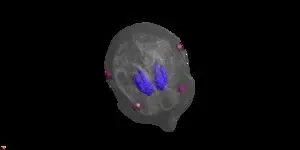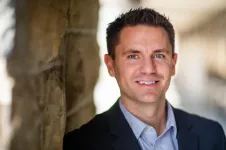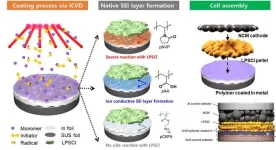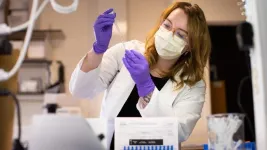(Press-News.org) As a newly developed perovskite with a large amount of intrinsic oxygen vacancies, BaSc0.8W0.2O2.8 achieves high proton conduction at low and intermediate temperatures, report scientists at Tokyo Tech. By the donor doping of large W6+, this material can take up more water to increase its proton concentration, as well as reduce the proton trapping through electrostatic repulsion between the dopant and proton. These findings could pave the way to the rational design of novel perovskites for protonic ceramic fuel cells (PCFCs) and electrolysis cells (PCECs).
In line with global efforts towards cleaner energy technologies, fuel cells may soon become an indispensable tool for converting chemical energy—stored in the form of hydrogen or other fuels—into electrical energy. Among the various types of fuel cells being actively researched, those that use solid electrolytes rather than liquid ones have inherent safety and stability advantages.
In particular, protonic ceramic fuel cells (PCFCs) have attracted special attention among scientists. These devices do not operate via the conduction of oxide ions (O2−) but light protons (H+) with smaller valence. A key feature of PCFCs is their ability to function at low and intermediate temperatures in the range of 50–500 °C. However, PCFCs based on perovskite electrolytes reported thus far suffer from low proton conductivity at low and intermediate temperatures.
In a recent study, a research team led by Professor Masamoto Yashima from Tokyo Institute of Technology (Tokyo Tech), in collaboration with High Energy Accelerator Research Organization (KEK), has set out to address this limitation of perovskite-based proton conductors. Their findings were published in the Journal of Materials Chemistry A on May 3, 2024.
But why is the conductivity of the conventional perovskite-type proton conductors so low? “A major problem with the conventional proton conductors is a phenomenon known as proton trapping, in which protons are trapped by acceptor dopant via electrostatic attraction between the dopant and proton,” explains Yashima. “Another major problem among such proton conductors would also be their low proton concentration due to the small amount of oxygen vacancies.”
To tackle these issues, the researchers developed a highly oxygen-deficient perovskite, namely BaScO2.5 doped with W6+ cations, or BaSc0.8W0.2O2.8 . Thanks to its large amounts of oxygen vacancies, this material has a higher proton concentration than other proton-conducting perovskites. However, since proton hopping occurs between oxygen atoms, the oxygen vacancies would lower proton conductivity rather than increase it.
This problem was solved by full hydration of the perovskite, turning it into BaSc0.8W0.2O3H0.4. Because of the large size of the W6+ dopant, the perovskite has a larger lattice volume, which means it can take up more water molecules than those doped with other cations such as small Mo6+. The high water uptake facilitates high proton conductivity by further increasing the proton concentration.
As for proton trapping, the high positive charge of the W6+ dopant leads to a stronger repulsion with protons, which are also positively charged. This effect was confirmed through ab initio molecular dynamics simulations, which revealed the migration pathways of protons near the Sc cation when transporting across the material. The repulsion indicates reduced proton trapping by the W6+ dopant, which leads to the high proton conductivity at low and intermediate temperatures.
Taken together, the insights provided by this study could help establish fundamental design principles for proton-conducting perovskites. “The stabilization of perovskites with disordered intrinsic oxygen vacancies and full hydration enabled by doping of large donor dopant could be an effective strategy towards next-generation proton conductors,” remarks Yashima.
In addition to PCFCs, proton conductors are also needed in proton-conducting electroysis cells (PCECs), which can efficiently utilize electricity. Both of these technologies will be essential in the near future as we collectively strive towards sustainability through novel proton conductors.
Overall, the present findings may open new avenues to realize clean energy societies.
###
About Tokyo Institute of Technology
Tokyo Tech stands at the forefront of research and higher education as the leading university for science and technology in Japan. Tokyo Tech researchers excel in fields ranging from materials science to biology, computer science, and physics. Founded in 1881, Tokyo Tech hosts over 10,000 undergraduate and graduate students per year, who develop into scientific leaders and some of the most sought-after engineers in industry. Embodying the Japanese philosophy of “monotsukuri,” meaning “technical ingenuity and innovation,” the Tokyo Tech community strives to contribute to society through high-impact research.
https://www.titech.ac.jp/english/
END
Vaccination remains the most effective strategy for avian influenza prevention and control in humans, despite varying vaccine efficacy across strains.
That’s according to the authors of a new review which delves into existing research into bird flu vaccines for humans.
Published in the peer-reviewed journal Human Vaccines & Immunotherapeutics, the results of the paper are particularly timely following news last week (Wednesday 22nd May) that the bird flu strain H5N1 had once again, for a second time, jumped from cattle in America to a human – prompting fears of subsequent human-to-human infection, with possible critical consequences.
Instances ...
62% of Marine Protected Areas (MPAs) designated to protect rare migratory fish species are outside of their core habitats, according to a new modelling study. The findings are published in the British Ecological Society’s Journal of Applied Ecology.
A team of researchers in France from the “Pole MIAME” that gathers diadromous fish experts from multiple research institutions (OFB, INRAE, Institut Agro and UPPA) have developed a new modelling approach that accurately predicts core and unsuitable habitats of rare and data-poor ...
The advancement of urbanization and globalization has impacted every corner of the Earth, human activities have transformed over one-third of the planet’s ecosystems, including agricultural lands and urban areas. Thus, there is an urgent need to define and achieve the equilibrium of novel ecosystems.
This study employed pragmatic designed experiments as its core method, integrating methodologies from empiricism, positivism, and romanticism to propose a semi-empirical ecological design framework that emphasizes learning by doing and research through practice. ...
A new study by Chinese scientists, released on May 29 in Shanghai, has called for the use of consumption-based accounting (“CBA”) emissions in calculating global carbon emissions in order to help make allocating responsibility for reducing emissions just and fair.
The study, “Research Report on Consumption-based Carbon Emissions (2024)” (“the Report”), was jointly completed by scientists from several institutes under the Chinese Academy of Sciences (CAS) as well as from Tsinghua University.
The ...
The depletion of energy resources poses a significant threat to the development of human society. Specifically, a considerable amount of low-grade heat (LGH), typically below 100 °C, is currently being wasted. However, if harnessed effectively, it has the potential to significantly improve overall energy utilization efficiency and subsequently reduce carbon dioxide emissions.
A research group of Junyong Hu from Taiyuan University of Technology has concentrated on developing a new type of reverse electrodialysis ...
The Colorado River is a lifeline for many cities and farms in the Southwest United States. It flows for about 1,448 miles before reaching the Gulf of California in Mexico and supplies water to numerous cities and farms along the way.
However, over the past 60 years, the amount of water in the Colorado River has been shrinking. In fact, in some years, the river’s water has been used up completely before it reaches the gulf.
Landon Marston, assistant professor in civil and environmental engineering, teamed up with researchers from multiple universities and ...
According to a recent study published in Chemical Engineering Journal, a collaborative research team led by Professor WANG Hui from High Magnetic Field Laboratory, Hefei Institutes of Science of Chinese Academy of Sciences developed magnetite nanozyme (MNZs) with dual enzymatic activities through structural engineering, and proved its structure-dependent behavior in the process of tumor treatment.
MNZs, as a substitute for natural enzymes, has been widely studied in the field of tumor catalytic therapy. However, the catalytic efficiency of traditional MNZs in tumor microenvironment (TME) is often limited, which is mainly due to the low production rate of hydroxyl radical ...
People have various relationships in society including those with family, friends, and coworkers. While these relationships play a significant role in our lives, it's crucial to maintain a healthy distance as being too close can lead to intense emotions or conflicts. Interestingly, a recent study in the field of chemistry demonstrates that maintaining such distance can enhance battery performance in electric vehicles.
In this research, Professor Soojin Park, Dr. Sungjin Cho and Youngjin Song, a PhD student, from the Department of Chemistry at Pohang University of Science and Technology (POSTECH) in collaboration with the team of Professor Sung Gap Im ...
May 28, 2024
For more information, contact:
Nicole Fawcett, nfawcett@umich.edu
EMBARGOED for release at 6:30 p.m. ET May 28, 2024
Altering cancer treatment dosing could reduce climate impact, study finds
Model estimates potential to reduce greenhouse gas emissions by delivering treatment every 6 weeks
ANN ARBOR, Michigan — Changing how often a popular cancer therapy is delivered would reduce greenhouse gas emissions and improve environmental impact without decreasing cancer survival, according to a new analysis from researchers at the University of Michigan Health Rogel ...
Corals play an essential role in ocean ecosystems, and like many organisms, they are under threat from climate change and other human activities. To better protect coral, it’s first necessary to understand them, in particular their reproductive life cycle, which only happens once a year. For the first time, researchers have produced a model for coral spawning, based on various environmental factors. They achieved this by tapping an often overlooked source of aquatic knowledge, an aquarium.
Given their branching shapes or waving tendrils, you would be ...









